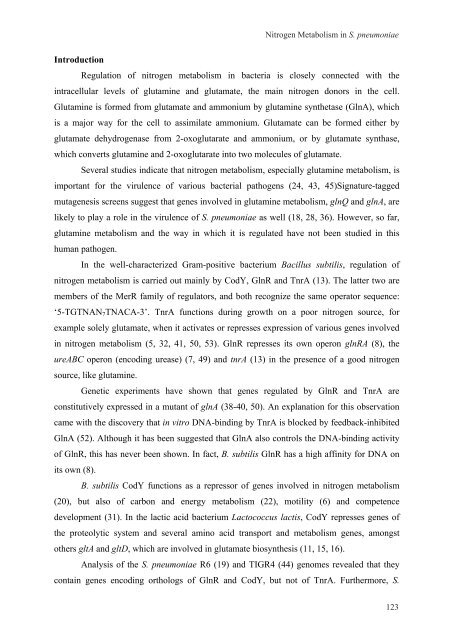Gene regulation in Streptococcus pneumoniae - RePub - Erasmus ...
Gene regulation in Streptococcus pneumoniae - RePub - Erasmus ...
Gene regulation in Streptococcus pneumoniae - RePub - Erasmus ...
Create successful ePaper yourself
Turn your PDF publications into a flip-book with our unique Google optimized e-Paper software.
Introduction<br />
Regulation of nitrogen metabolism <strong>in</strong> bacteria is closely connected with the<br />
<strong>in</strong>tracellular levels of glutam<strong>in</strong>e and glutamate, the ma<strong>in</strong> nitrogen donors <strong>in</strong> the cell.<br />
Glutam<strong>in</strong>e is formed from glutamate and ammonium by glutam<strong>in</strong>e synthetase (GlnA), which<br />
is a major way for the cell to assimilate ammonium. Glutamate can be formed either by<br />
glutamate dehydrogenase from 2-oxoglutarate and ammonium, or by glutamate synthase,<br />
which converts glutam<strong>in</strong>e and 2-oxoglutarate <strong>in</strong>to two molecules of glutamate.<br />
Several studies <strong>in</strong>dicate that nitrogen metabolism, especially glutam<strong>in</strong>e metabolism, is<br />
important for the virulence of various bacterial pathogens (24, 43, 45)Signature-tagged<br />
mutagenesis screens suggest that genes <strong>in</strong>volved <strong>in</strong> glutam<strong>in</strong>e metabolism, glnQ and glnA, are<br />
likely to play a role <strong>in</strong> the virulence of S. <strong>pneumoniae</strong> as well (18, 28, 36). However, so far,<br />
glutam<strong>in</strong>e metabolism and the way <strong>in</strong> which it is regulated have not been studied <strong>in</strong> this<br />
human pathogen.<br />
In the well-characterized Gram-positive bacterium Bacillus subtilis, <strong>regulation</strong> of<br />
nitrogen metabolism is carried out ma<strong>in</strong>ly by CodY, GlnR and TnrA (13). The latter two are<br />
members of the MerR family of regulators, and both recognize the same operator sequence:<br />
‘5-TGTNAN7TNACA-3’. TnrA functions dur<strong>in</strong>g growth on a poor nitrogen source, for<br />
example solely glutamate, when it activates or represses expression of various genes <strong>in</strong>volved<br />
<strong>in</strong> nitrogen metabolism (5, 32, 41, 50, 53). GlnR represses its own operon glnRA (8), the<br />
ureABC operon (encod<strong>in</strong>g urease) (7, 49) and tnrA (13) <strong>in</strong> the presence of a good nitrogen<br />
source, like glutam<strong>in</strong>e.<br />
<strong>Gene</strong>tic experiments have shown that genes regulated by GlnR and TnrA are<br />
constitutively expressed <strong>in</strong> a mutant of glnA (38-40, 50). An explanation for this observation<br />
came with the discovery that <strong>in</strong> vitro DNA-b<strong>in</strong>d<strong>in</strong>g by TnrA is blocked by feedback-<strong>in</strong>hibited<br />
GlnA (52). Although it has been suggested that GlnA also controls the DNA-b<strong>in</strong>d<strong>in</strong>g activity<br />
of GlnR, this has never been shown. In fact, B. subtilis GlnR has a high aff<strong>in</strong>ity for DNA on<br />
its own (8).<br />
Nitrogen Metabolism <strong>in</strong> S. <strong>pneumoniae</strong><br />
B. subtilis CodY functions as a repressor of genes <strong>in</strong>volved <strong>in</strong> nitrogen metabolism<br />
(20), but also of carbon and energy metabolism (22), motility (6) and competence<br />
development (31). In the lactic acid bacterium Lactococcus lactis, CodY represses genes of<br />
the proteolytic system and several am<strong>in</strong>o acid transport and metabolism genes, amongst<br />
others gltA and gltD, which are <strong>in</strong>volved <strong>in</strong> glutamate biosynthesis (11, 15, 16).<br />
Analysis of the S. <strong>pneumoniae</strong> R6 (19) and TIGR4 (44) genomes revealed that they<br />
conta<strong>in</strong> genes encod<strong>in</strong>g orthologs of GlnR and CodY, but not of TnrA. Furthermore, S.<br />
123<br />
123

















